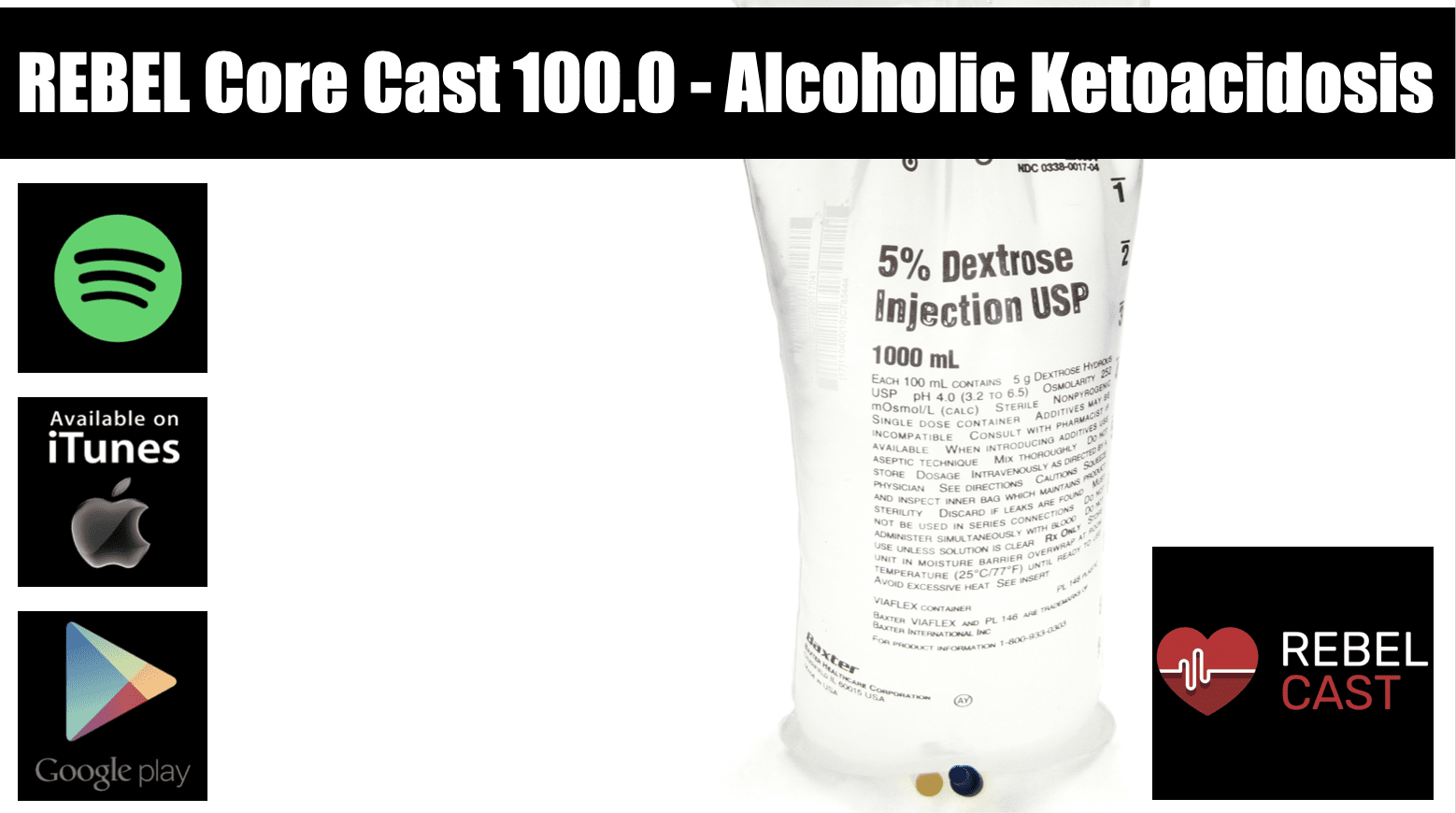
 Take Home Points
Take Home Points
- Alcoholic Ketoacidosis (AKA) can present with significant acidemia (pH < 7.00). Despite the significant acidemia, patients with AKA can remain alert and lucid despite their severe metabolic derangement.
- Relying on urine ketones for diagnosis can be misleading, as acetoacetate is the primary ketone detected in the urine but not the most common ketone generated in AKA. Given the redox ratio in patients with severe ethanol use disorder, urine ketones may be low or negative, as beta-hydroxybutyrate is the predominant ketone body.
- Treatment consists of thiamine, dextrose, and volume repletion.
- Remember to evaluate for concurrent medical illness: gastritis, pancreatitis, pyelonephritis, pneumonia, sepsis.
REBEL Core Cast 100.0 – Alcoholic Ketoacidosis
Definition and Physiology
- Alcoholic ketoacidosis is a starvation state that occurs in the patient with severe ethanol use disorder.
- The normal response to starvation is to utilize hepatic glycogen stores in order to generate glucose.
- In patients with severe ethanol use disorder who are malnourished, fatty acids and proteins are broken down to generate ketone bodies which are utilized by both the brain and heart.
- Note that the metabolism of ethanol increases the NADH:NAD+ ratio. This in turn diverts pyruvate to lactate (accounting for the presence of lactate in this population) and inhibits gluconeogenesis. As a result, patients with AKA tend to presents with a low or low/normal glucose concentration.
Clinical Manifestations
- Typical presentation: nausea, vomiting, and abdominal discomfort in the context of poor nutritional intake in a patient with ethanol use disorder.
- Physical examination
- Kussmaul breathing (in order to compensate for a severe metabolic acidosis). However, in contrast to other cases of respiratory compensation, there is a tendency for patients presenting with AKA to maintain their mental status and remain lucid.1
- Tachycardia may be present due to significant volume loss.
- Evaluate for concurrent Wernicke’s Encephalopathy: classic triad of encephalopathy, ophthalmoplegia (classically nystagmus and lateral rectus palsy), and ataxia.2
- Ethanol concentrations may be low or undetectable. Glucose concentrations may be low or normal. Other electrolyte abnormalities including hypokalemia and hypomagnesemia can be found.
- Severe metabolic acidemia can occur which is out of proportion compared to the patient’s clinical presentation. pH < 7.00 has been reported.3
Diagnosis
- High Pre-Test Probability Patient: poor PO intake in a patient with ethanol use disorder
- Metabolic Acidemia + Lactate
- +Beta-Hydroxybutyrate
Management
- Sufficient dextrose containing crystalloid replacement in order to restore volume loss. (D5/NS or D5/LR)
- Oral nutrition if patient is able to tolerate. If not, dextrose containing fluids will suffice.
- Thiamine 100mg IV4
- Fix electrolyte abnormalities (Hypokalemia, Hypomagnesemia)
- Administration of bicarbonate is generally unnecessary.
Take Home Points
- Alcoholic Ketoacidosis (AKA) can present with significant acidemia (pH < 7.00). Despite the significant acidemia, patients with AKA can remain alert and lucid despite their severe metabolic derangement.
- Relying on urine ketones for diagnosis can be misleading, as acetoacetate is the primary ketone detected in the urine but not the most common ketone generated in AKA. Given the redox ratio in patients with severe ethanol use disorder, urine ketones may be low or negative, as beta-hydroxybutyrate is the predominant ketone body.
- Treatment consists of thiamine, dextrose, and volume repletion.
- Remember to evaluate for concurrent medical illness: gastritis, pancreatitis, pyelonephritis, pneumonia, sepsis.
References
- Wrenn KD, Slovis CM, Minion GE, Rutkowski R. The syndrome of alcoholic ketoacidosis. Am J Med. 1991 Aug;91(2):119-28. doi: 10.1016/0002-9343(91)90003-g. PMID: 1867237.
- https://coreem.net/core/wernicke-encephalopathy/
- Fulop M, Hoberman HD. Alcoholic detosis. Diabetes. 1975 Sep;24(9):785-90. doi: 10.2337/diab.24.9.785. PMID: 808436.
- https://coreem.net/core/alcoholic-ketoacidosis/
Post Created By: Sanjay Mohan, MD
Post Peer Reviewed By: Salim R. Rezaie, MD (Twitter: @srrezaie)
The post REBEL Core Cast 100.0 – Alcoholic Ketoacidosis appeared first on REBEL EM - Emergency Medicine Blog.
